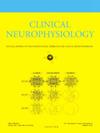实时检测缺勤发作
IF 3.7
3区 医学
Q1 CLINICAL NEUROLOGY
引用次数: 0
摘要
目的失神发作的特点是注意力的变化,可能导致危险的情况。我们开发了一种实时癫痫检测算法,用于在线检测缺勤。我们的目标是将该算法集成到评估应用程序中,使缺勤时的注意力测量成为可能。方法对单通道脑电数据进行连续小波变换。我们对22名缺勤儿童患者连续24小时的脑电图记录进行了离线测试。我们用49例常规脑电图和12例动态记录外部验证了我们的算法。为了量化算法的性能,我们确定了灵敏度、假阳性率、首次检测时间和F1评分。结果在我们的测试数据集中,我们获得的平均灵敏度为97.9%,假阳性率为1.20/h, F1评分为0.82。除1例患者外,到检测的中位时间为2 s。在我们的验证集中,平均灵敏度为95%,F1得分为0.88。常规和门诊记录的平均假阳性率分别为5.6和4.5/h。到第一次检测的中位时间为1.1 s。结论sour算法检测失神发作速度快,灵敏度高,适合集成到计算机化反应时间任务中。高假阳性率表明仔细审查结果的重要性。该算法有潜力在临床和研究应用中发挥有用的作用,旨在研究缺席期间的短暂性注意力受损。本文章由计算机程序翻译,如有差异,请以英文原文为准。
Real-time detection of absence seizures
Objective
Absence seizures are characterized by changes in attention, potentially leading to hazardous situations. We developed a real-time seizure detection algorithm for online detection of absences. Our aim is to integrate this algorithm into an assessment application, enabling the measurement of attention during absences.
Methods
Our algorithm uses a continuous wavelet transform of single-channel EEG data. We tested the algorithm offline on 22 continuous 24-hour EEG recordings of pediatric patients with absences. We externally validated our algorithm with 49 routine EEGs and twelve ambulatory recordings. To quantify the algorithm’s performance, we determined sensitivity, false positive rate, time to first detection and F1 score.
Results
In our test dataset, we obtained an average sensitivity of 97.9 %, a false positive rate of 1.20/h and an F1 score of 0.82. Except for one patient, the median time until detection was <2 s. In our validation set, an average sensitivity of 95 % and an F1 score of 0.88 was reached. The average false positive rate was 5.6/h and 4.5/h for the routine and ambulatory recordings, respectively. The median time until first detection was 1.1 s.
Conclusions
Our algorithm demonstrates fast detection of absence seizures with a high sensitivity, making it suitable for integration in a computerized reaction time task. The high false positive rate indicates the importance of a careful review of the results.
Significance
The algorithm has the potential to play a useful role in the advancement of clinical and research applications aimed at studying transient impaired attention during absences.
求助全文
通过发布文献求助,成功后即可免费获取论文全文。
去求助
来源期刊

Clinical Neurophysiology
医学-临床神经学
CiteScore
8.70
自引率
6.40%
发文量
932
审稿时长
59 days
期刊介绍:
As of January 1999, The journal Electroencephalography and Clinical Neurophysiology, and its two sections Electromyography and Motor Control and Evoked Potentials have amalgamated to become this journal - Clinical Neurophysiology.
Clinical Neurophysiology is the official journal of the International Federation of Clinical Neurophysiology, the Brazilian Society of Clinical Neurophysiology, the Czech Society of Clinical Neurophysiology, the Italian Clinical Neurophysiology Society and the International Society of Intraoperative Neurophysiology.The journal is dedicated to fostering research and disseminating information on all aspects of both normal and abnormal functioning of the nervous system. The key aim of the publication is to disseminate scholarly reports on the pathophysiology underlying diseases of the central and peripheral nervous system of human patients. Clinical trials that use neurophysiological measures to document change are encouraged, as are manuscripts reporting data on integrated neuroimaging of central nervous function including, but not limited to, functional MRI, MEG, EEG, PET and other neuroimaging modalities.
 求助内容:
求助内容: 应助结果提醒方式:
应助结果提醒方式:


